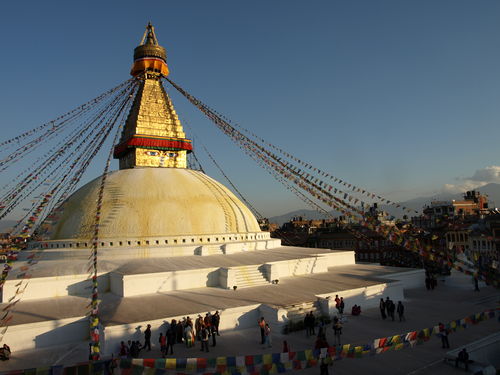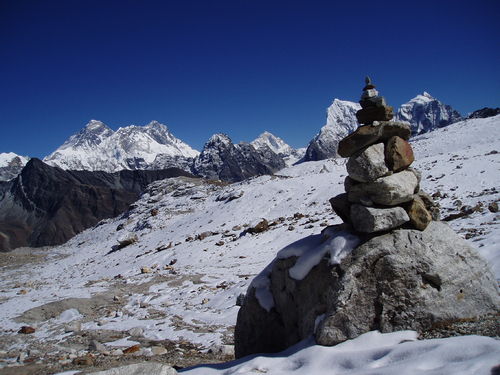Program of the Kathmandu 2012 Workshop
Bodhnath Stupa
Schedule
Talks are scheduled in slots of 30 minutes (including discussions). However, as the program is very tight, the organizers recommend that the talks should be kept shorter. If this is achieved, there will be more time for discussions during the breaks.
| Monday April 30 | Tuesday May 1 | Wednesday 2 May | Thursday 3 May | Friday 4 May | |
|---|---|---|---|---|---|
| 9:00 - 9:30 | Pal | Gross | Broer | Minot | |
| 9:30 - 10:00 | Witek | Calaminici | Daul | Markovits | |
| 10:00 - 10:30 | Cioslowski | Fuentealba | Helgaker | Chen | |
| 10:30 - 11:00 | Break | Break | Break | Break | |
| 11:00 - 11:30 | Okopinska | Yang | Borgis | Hiberty | |
| 11:30 - 12:00 | Causa | Görling | Dobson | Braida | |
| 12:00 - 12:30 | Wesolowski | Chermette | Frauenheim | Derat | |
| 12:30 - 13:00 | Chan | Grabowski | Kronik | Salahub | |
| 13:00 - 15:00 | Lunch | Lunch | Lunch | Lunch | |
| 15:00 - 15:30 | Ernzerhof | Excursion to Patan | Delgado Barrio | Excursion to Bodhnath | |
| 15:30 - 16:00 | Scuseria | Carniato | |||
| 16:00 - 16:30 | Welcome | van Aggelen | Martin Pendas | ||
| 16:30 - 17:0 | Piris | Cardenas | |||
| 17:00 - 17:30 | Opening | Break | Break | ||
| 17:30 - 18:00 | Malrieu | Ayers | Graovac | ||
| 18:00 - 18:30 | Harris | Russo | Schwerdtfeger | ||
| 18:30 - 19:00 | Mukherjee | Bultinck | Liu | ||
| 19:00 - 19:30 | Schwarz | Baer | Discussions / Posters | ||
| 20:00 - 20:30 | |||||
| 20:30 - | Conference dinner |
Speakers and titles of the talks
- Helen van Aggelen: Variational optimization of second order density matrices for chemistry
- Paul Ayers: What Should One Do When Electronic Structure Methods Aren’t Good Enough? Machine-Learning Methods for Molecular Properties
- Roi Baer: Dogmatic and Pragmatic Spirits in Density Functional Theory
- Daniel Borgis: Classical Density Functional Theory and its Application to Chemistry
- Benoit Braida: Recent trends in ab initio Valence Bond methods
- Ria Broer: First principles Studies of Magnetic Interactions in Molecules and Solids
- Patrick Bultinck: Chemical verification of new quantum chemical methods
- Patrizia Calaminici: Finite Systems Properties from Born-Oppenheimer Molecular Dynamics
- Carlos Cardenas: Navigating the Hard-Soft Acids-Bases Principle
- Stephane Carniato: How RIXS and theory can be combined to measure the electronegativity
- Mauro Causa: Locality and non-locality. It is possible to cut a system governed by quantum mechanics
- Garnet Chan: Quantum embedding theories
- Guanhua Chen: Penetrating a potential barrier one hundred percent
- Henry Chermette: The Gradient-Regulated Connection of Generalized Gradient Exchange Functionals: interest and limitations
- Jerzy Cioslowski: All you always wanted to know about many-electron harmonium atoms
- Claude Daul: Prediction of single-molecular magnets with open d- or f-shells by theoretical calculations
- Gerardo Delgado Barrio: Theoretical studies of Helium clusters doped with diatomic molecules
- Etienne Derat: Models for complex bioinorganic systems: a tool for future design?
- John Dobson: Dispersion Forces
- Matthias Ernzerhof: Non-Hermitian quantum mechanics and density functional theory
- Thomas Frauenheim: DFTB - Recent methodological extensions, applications and challenges
- Patricio Fuentealba: The richness of the dynamics of clusters and molecules
- Andreas Gorling: The adiabatic-connection dissipation-fluctuation theorem as route to a new generation of density-functional methods: perspectives and challenges
- Irek Grabowski: Impact of the correlation effects on the KS DFT potentials, energies and densities
- Ante Graovac: On topology versus geometry in molecules
- Frank Harris: Fully Correlated Wavefunctions for Small Atoms
- Hardy Gross: Exact factorisation of the electron-nuclear wave function: A fresh look on potential energy surfaces and the semi-classical treatment of nuclei
- Trygve Helgaker: The universal density functional in external magnetic field
- Philippe Hiberty: Valence Bond Theory and Reactivity: Correlation Between the Diradical Character of 1,3-Dipoles and their Reactivity Toward Ethylene and Acetylene
- Leeor Kronik: Understanding photoelectron spectroscopy from first principles - progress and challenges
- Wenjian Liu: Relativistic correlation
- Jean-Paul Malrieu: Scale changes and reduction of the degrees of freedom in wave-function calculations
- Alexis Markovits: The Active Role of the Surface in Heterogeneous Catalysis
- Ángel Martín Pendás: Fluctuation of electron populations and chemical bonding
- Christian Minot: Reducibility of metal oxides
- Debashis Mukherjee: Reflections on interplay of dynamical and static correlations : paradigms and approaches
- Anna Okopinska: Entanglement in natural and artificial atoms and molecules
- Sourav Pal: Coupled cluster theory: stationary or non-stationary?
- Mario Piris: Can NOFT bridge the gap between DFT and WFT?
- Nino Russo: How to choose the exchange-correlation potential for different systems or processes: menu à la carte ou menu du jour ?
- Dennis Salahub: Electron transfer and other reactions in proteins – towards an understanding of the effects of quantum decoherence
- W.H.E. Schwarz: Descriptive and Explanative Concepts of Theory for Chemistry
- Peter Schwerdtfeger: Beyond the Periodic Table – Going for the Superheavy Elements
- Gustavo Scuseria: Symmetry breaking & restoration
- Tomasz Wesolowski: Joining seamlessly microscopic and macroscopic levels of description of matter: challenges and perspectives for modelling methods based on Frozen-Density Embedding Theory
- Henryk Witek: Exact solution of Schrodinger equation for helium: how far are we?
- Weitao Yang: Fukui functions: Analytic evaluation and new exact conditions from the flat plans.
Posters
- Deba B. Khadka: Optical model calculation of the total Penning ionization cross sections of Ne(3P1) by O2
- Claire C. Ralph: Time Evolution of Matrix Product States and its Application to NMR
Abstracts
Mt Everest, Lhotse and Cholatse seen from Renjo La

